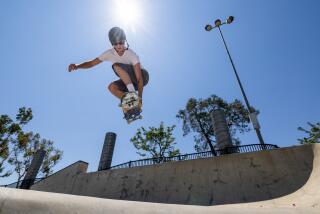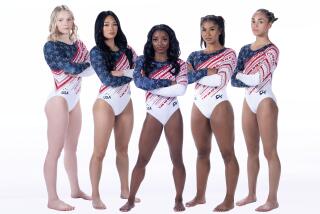At Olympics, the Race Is to the Swiftest Outfits Science Can Sew
- Share via
As Olympic speedskaters move to the starting line Saturday for the first of their races, they will be wearing the best that science can offer.
Ditto for the other winter sports that will be showcased in the coming weeks. Even the clunky sport of curling (a kind of shuffleboard on ice) has its innovations.
But the most persistent buzz in Salt Lake City has been about the speedskaters’ skintight racing suits, with sports apparel giant Nike leading the way.
At first glance, the Nike suit doesn’t look much different from any other of the one-piece stretch garments that cover racers from head to skate. But the Nike Swift Skin, as it has been christened, is made up of six kinds of fabric, each designed to enhance a skater’s speeds by cutting drag and friction. For instance, a fabric with a slick finish covers the fastest-moving body parts--hands and skates. A mesh fabric on the arms creates a dimpled effect, similar to that of a golf ball, to aid in cutting through the air. All this, so that skaters using the suits can cut mere milliseconds off their times. Those fractions of time, though, could mean the difference between winning and finishing far back in the pack.
“The skaters have been very, very pleased,” said Rick McDonald, Nike’s director of innovation, who is also quick not to give the suits complete credit for recent fast times around the Olympic oval. “You can’t attribute the good times to any one particular thing because so many factors enter into going fast.”
Nike, of course, is not alone in developing skating suits. In fact, the company is a relatively recent entry into the sport, which Japan-based rival Descente is quick to point out.
Descente spokeswoman Kathryn Johnson said her company spent an estimated 3,000 hours since the Nagano Winter Olympics improving the speed suits used by the always-competitive Canadian team. The Descente suits, which use tiny ribs to channel airflow over the body, weigh in at a scant 185 grams.
“They are a constant work in progress,” Johnson said. “What is a wonderful suit today could be obsolete in six months. What was good for Nagano may not be the best suit for Salt Lake City.”
The Descente line made for some humorous headlines last January when the Canadian team was racing at the world sprint championships in Norway. Happy-face underwear was clearly visible through speedskater Krisy Myers’ skintight yellow suit. Johnson said the Olympic uniform will be darker and less revealing.
Besides the racing suits, Descente is also making the team’s warmup apparel, described unabashedly by the company as “shaped to wrap the athlete in tranquil security. A molded garment that comfortably wraps around the body to provide a cocoon of peace and tranquillity.”
Sometimes winter racing clothing is too fast. In the mid-1990s, the sports outfitter Spyder introduced a ski racing suit called the Speedwyre, whose users promptly began winning an inordinate number of races. Racers under contract to other clothing manufacturers complained they couldn’t compete against the new design and in 1997, the International Ski Federation banned the Speedwyre’s use. Spyder, which equips the U.S. ski team, still chafes at the ban, especially because of the technological advances in other aspects of winter sports.
“New technology is embraced for hard goods like ski poles and boots,” said Laura Orlowski, Spyder’s promotions and media manager. “Other sports are embracing new technology, such as swimming and speedskating. Their athletes are allowed to wear aerodynamic race wear.”
Nike, not wanting to chance any quick reproduction of its racing suits by other manufacturers, kept a tight security lid on them until last month. Small wonder, given the amount of testing the company did, including wind tunnel experiments in Washington and British Columbia.
Athletes finally got a look at them last fall, but only in strict secrecy behind the locked doors of the Olympic oval in Salt Lake City. Nike officials made sure they were present on the track and in the locker rooms to keep security tight and prying eyes out.
As the Olympics are about to start, McDonald said most of the work involves last-minute changes, using a cadre of pattern makers and seamstresses imported for the occasion to make last-minute alterations. The suits are so tight that it’s impossible to make standard sizes.
“You can make the fastest suit in the world, but if you can’t skate in it, it doesn’t mean much,” McDonald said.
Skaters from the United States, the Netherlands and Australia will wear the Nike speed suits while only the Canadians will don Descente’s. Olympic federations from other countries have entered into agreements with other companies to provide racing suits, which come under the heading of team uniforms.
Nike and Descente have invested major funding for a sport that is hardly overflowing with participants. But both companies say the investment is worth it because of products that might evolve from their research.
“It’s kind of like a Formula One race car,” McDonald said. “It provides us with a technology platform.”
Or, as Johnson put it, “it’s not speedskating for us, per se. It gives us a reputation for excellence.”
*
(BEGIN TEXT OF INFOBOX)
Streamlined for Speed
(text of infobox not included)
Graphic reporting by BRADY MacDONALD /Los Angeles Times
More to Read
Go beyond the scoreboard
Get the latest on L.A.'s teams in the daily Sports Report newsletter.
You may occasionally receive promotional content from the Los Angeles Times.






